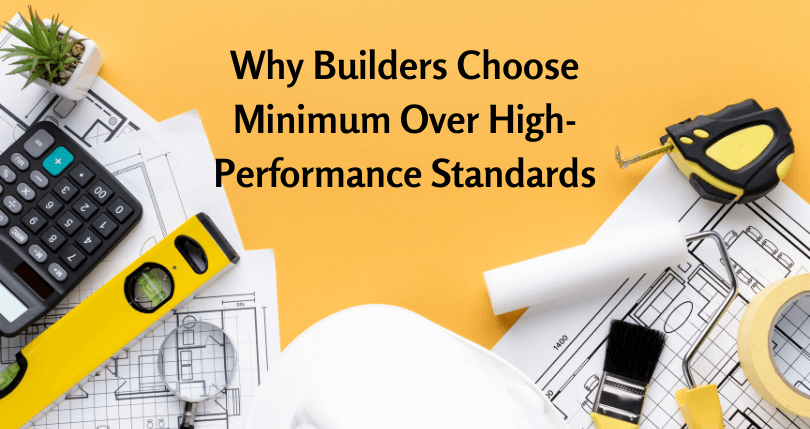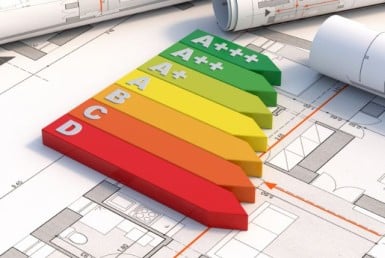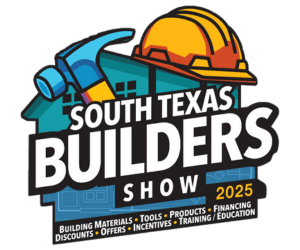Why Builders Choose Minimum Over High-Performance Standards
In the competitive world of home construction, many builders tend to construct homes that adhere only to the minimum standards set by local building codes. This decision, though seemingly practical, often overlooks the potential for building high-performance homes that not only offer increased energy efficiency but other more important long-term benefits to homeowners like enhanced comfort, better indoor air quality, and durability. Here’s an exploration of why builders favor minimum code homes over better, high-performance homes.
Cost and Complexity
The initial cost of building to superior performance standards can be higher than sticking to minimum codes. High-performance homes require advanced materials, properly installed insulation, high-efficiency HVAC systems that are properly sized, and specialized construction techniques like improved air sealing. In addition, the homes require inspections and testing by independent third-party home energy Raters. These materials and methods can be more expensive upfront and may complicate the construction process from what a builder typically does.
Builders face the reality of thin profit margins and intense competition. By constructing homes that just meet the minimum building codes, they can keep prices lower and homes more affordable for a larger segment of buyers. Moreover, integrating high-performance features often requires builders to invest in additional training for their crews and additional time to learn new ways of doing things. Unfortunately, what is not factored in is the generous financial incentives for the builder and, more importantly, the value of being differentiated as one of a few superior builders who go above and beyond what is required by minimum code standards to improve the quality of construction for their homebuyers
Market Demand and Education
Market demand heavily influences builders’ decisions. As one builder put it, “I am not going to spend money on something my homebuyers are not asking for.” This is a practical business decision. Unfortunately, many consumers make buying decisions on price and aesthetic features like exotic granite countertops and other beautiful features. There’s a prevalent lack of awareness among homebuyers about the long-term benefits of high-performance homes, such as reduced utility bills, enhanced home comfort, improved indoor air quality, and increased durability. This lack of demand results in builders focusing more on features that sell houses quickly, such as modern kitchen and appealing finishes, rather than the more important energy-efficient features. Without a huge demand for high-performance homes, builders keep building the same way that always worked for them.
Moreover, builders might not be fully aware of the financial incentives available for building high-performance homes, despite an available tax credit of $2,500 for an ENERGY STAR®home, and with additional generous incentives from local utility companies—incentives for ENERGY STAR® and BUILT TO SAVE® certified homes. Plus, for homebuyers, the initial higher cost of buying a verified high-performance home is more than offset by the long-term energy savings over the life of the home. Savings begin accumulating the day the homeowner moves in.
Regulatory and Labor Challenges
Building codes are designed to ensure basic safety and health standards and do not necessarily push the boundaries to include high-performance home features. Since the energy code is updated every six years and adoption and enforcement of the code vary unevenly across different cities, builders often stick to the minimum standards that are legally required.
Additionally, the construction industry is experiencing a shortage of skilled labor, which makes it even more challenging to implement advanced building techniques required for high-performance homes. This shortage can lead to delays and increased costs, making builders hesitant to move beyond traditional minimum building methods.
Short-term vs. Long-term Gains
The construction industry often operates on a short-term gain perspective, focusing on the immediate profitability of projects. High-performance homes, while beneficial in the long run through operational savings and increased home comfort, require a shift to a long-term investment mindset that many builders are not willing to make. They remain set in their comfort zone.
Conclusion
Despite the higher upfront costs and learning curve involved in building high-performance homes, the long-term benefits for homeowners and the environment are substantial.Future homebuyers need to be made aware and need to wake up and demand high-performance homes. These homes not only provide savings on energy costs but also contribute to healthier living environments and greater resilience to climate impacts. As consumer awareness and demand for energy-efficient homes increases, and as building codes evolve to prioritize sustainability and energy efficiency, it’s likely that more builders will begin to embrace high-performing standards as a competitive advantage in the housing market. And—right now, you can see a list of local builders here in the Rio Grande Valleywhobuck the status quo: who voluntarily choose to go above and beyond by building homes in the BUILT TO SAVE® high-performance home program.
Visit www.BuiltToSave.org to find out more about why you should not settle for a minimum code-built home when you can enjoy the savings and comfort of a high-performance home. You can also find builders enrolled in the BUILT TO SAVE® program offering high-performance homes.
© RGV New Homes Guide, 2024. Unauthorized use and/or duplication of this material without express and written permission from this site’s author and/or owner is strictly prohibited. Excerpts and links may be used, provided that full and clear credit is given to RGV New Homes Guide with appropriate and specific direction to the original content.









